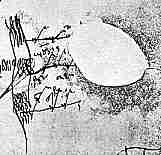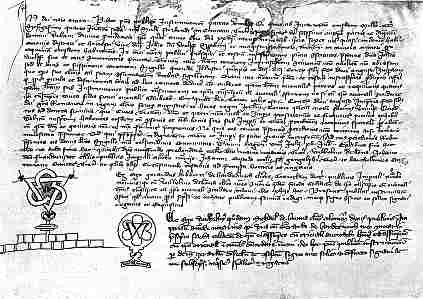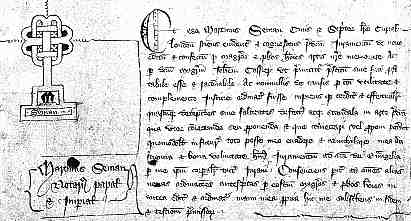



If you are looking at this page without frames, there is more information about medieval writing to be found by going to the home page (framed) or the site map (no frames).
| Notarial Documents | ||
| The practice of using notaries to not only scribe, but draft legal documents began in Classical Rome. This form of authorised legal expertise survived in areas like Italy, southern France and Spain, which retained aspects of Roman law and legal practice. It lapsed in the northern regions, was reinvented in the time of Charlemagne, and tended to lapse again after his demise. As literate modes of conducting business and law became steadily more entrenched from around the 12th century, the notary again appeared on the scene. | ||
| The most distinctive feature of notarial documents is the elaborate graphic sign with which each notary identified himself on the documents he prepared. This convention is found on royal diplomas of the Carolingian era, and the tradition continued in a range of documents of later eras. | ||
 |
Authenticating sign on a diploma of Charlemagne of AD 781 (Marburg, K. Preussisches Staatsarchiv). (From Steffens 1929) | |
| In this example the royal official who has authenticated the document has included an elaborate graphical device which includes an inscription in Tironian notes. | ||
 |
||
| Notarial transcript of a diploma of Konrad IV from 1364 (Trier, Stadtbibliothek, Archiv, E.22). (From Steffens 1929) | ||
| The above represents a transcript of a diploma of Konrad IV to the burghers of Trier, authenticated by two notaries. The upper section represents the charter itself. Below, each notary has added his special sign and a declaration of authenticity of the document. | ||
 |
||
| The second notary's sign and declaration from the above example. | ||
| Notaries were appointed by the German emperor or the pope, and their specialities were Roman and canon, or church, law. England was developing its own particular legal system in which notaries had a limited place. In England, notaries combined their profession with that of scrivener. These were much more generalised practitioners of the art of writing for hire. They had their own guilds, carried out tasks like conveyancing and set up shops where they would carry out any kind of writing task for remuneration. A notary could serve as a scrivener, but an ordinary scrivener did not have the same legal standing as a notary. | ||
 |
An entry from the Common Paper of the Scriveners' Company of London, of 1390, p.53. (From Jenkinson 1927) | |
| The above example is from a book of assorted records of the Scriveners' Company in which, among other things, new members who were sworn in to the company signed a declaration that they accepted the rules of the company. This, the second entry in the book, bears the name on the left Martinus Seman Notarius papalis et Imperalis (Martin Seman, papal and imperial notary), indicating that this particular member acted both as notary and scrivener. Above that is his notarial mark and on the right his declaration. The Company of Scriveners recruited apprentices, but it is not known whether they employed already literate scribes or taught writing skills at a basic level themselves. Nonetheless, legal and business writing had, by this time, become a fully fledged trade. | ||
|
If you are looking at this page without frames, there is more information about medieval writing to be found by going to the home page (framed) or the site map (no frames). |
||